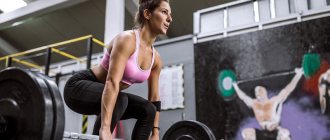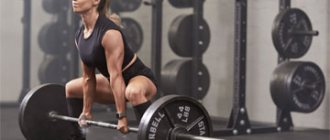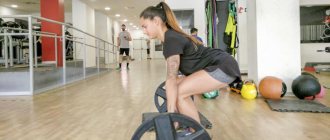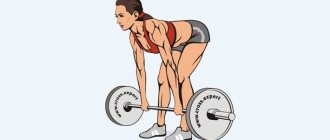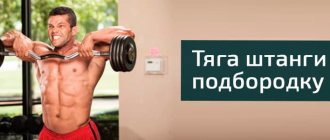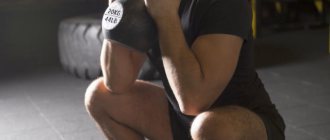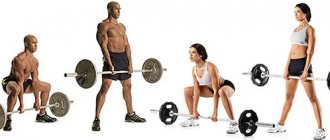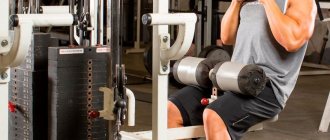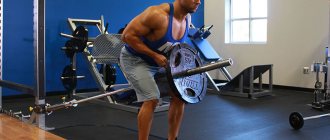Deadlift with a kettlebell is one of the variations of the basic exercise, aimed primarily at beginners, as well as girls. Unlike the classic version, the use of this projectile changes the center of gravity, which affects the distribution of the load.
Can be performed with either one or two weights. These two options are very different from each other and may well be called different exercises. When performed, they develop different muscle groups, so we will talk about them in turn.
Deadlift with a kettlebell: what muscles work
Depending on the execution technique, you can develop target muscles, such as: back, gluteal, quadriceps, hamstrings. The quadriceps femoris muscle is activated precisely when performing a classic deadlift, that is, on bent knees. Performing a deadlift does not involve the quadriceps, and is aimed at developing the biceps of the belly and buttocks, during which the muscles are stretched to the maximum, which does not happen in the classic version of the deadlift.
are also strengthened , especially the middle, lumbar extensors, and spinal stabilizers. The muscles of the abdomen, lower leg, delta (posterior bundle) are indirectly involved in the work
About the harm
Deadlifts, like other strength techniques, have many contraindications. If you ignore medical prohibitions, the harm to your health can be irreparable.
Specific contraindications:
- imbalance of the muscle corset. Common among those who are keen on different grips and have developed one side better than the other;
- any problems with the spine and lumbar back;
- rehabilitation period after operations and injuries;
- gastrointestinal ulcers;
- hypertension.
If you have problems with blood pressure, you should not use scales. If the necessary breathing technique is observed, hypertensive patients experience an exacerbation of the disease. Any deadlift should not be done after pull-ups. The fact is that when pulling up, the spinal discs relax and stretch; if you then begin to pull the weight, pinching will occur.
The exercise will not bring benefit, but harm if you do it incorrectly or exceed your normal load. If you neglect the technique, a microdislocation of the lumbar region may occur, and the formation of a vertebral hernia is possible.
Benefits of Kettlebell Rows
- Develops muscles, strengthens core muscles, and provides a powerful anabolic boost to the entire body when performing heavy deadlifts.
- Develops endurance when performing high repetitions.
- Strengthens the cardiac and respiratory systems.
- Increases joint flexibility and elasticity of muscles and ligaments, since muscle fibers can be stretched when bending over.
- Helps reduce weight through loss of adipose tissue at high energy costs.
Attention! The only contraindications to performance are injuries and diseases of the spine. When performing the correct exercise technique, injuries are reduced to zero, since they are performed in a concentrated manner with the correct position of the back.
Newbie mistakes
Incorrect execution technique leads not only to lack of results, but also to injuries. The most common mistakes made during training are:
- loss of balance. It occurs due to poor coordination of movements, as a result the projectile begins to deviate from the required vector of movement;
- sudden quick movements. Lead to stretching, all actions should be performed smoothly;
- rounding of the spine. At high weight it leads to injury;
- incorrect head position. It should be smooth, the gaze directed forward.
If one of these situations occurs while performing a deadlift with a kettlebell, the exercise must be stopped immediately:
- pain in the lower back or back. Deadlifts should be preceded by exercises to strengthen the lumbar region, pelvis and chest; they serve as a preparatory stage;
- discomfort in the knees. Pain or mild discomfort is a sign that training should be stopped immediately. If a crunching sensation appears, you should visit a doctor;
- dizziness, confusion. Indicate problems with blood vessels.
Where to begin
- Select a light load weight, perform the deadlift technique with a minimum weight of the kettlebell, then move on to a heavy working weight, depending on the training goal.
- Be sure to warm up your muscles and ligaments before starting your workout. It is also important to stretch the muscles after exercise, despite the fact that the exercise promotes fiber elongation.
- Learn a simple technique; after practicing deadlifts with one kettlebell, you can start deadlifting with two kettlebells.
Number of approaches and weight
As with any exercise, these numbers depend on what your goals are. If you need to gain muscle mass, then you should do it in 3-4 sets of 12 repetitions. The repetitions should be performed slowly and under control without jerking.
If you want to work on definition and are working on drying, then you should do 4-5 sets of 15-20 repetitions. In this case, you need to use lighter weight equipment, and try to do the exercise as quickly as possible, but without compromising the correct technique.
Technique for performing deadlifts with one kettlebell
- Place your feet hip-width apart, you can turn your toes slightly out.
- Bend over with a straight back and clasp the handle of the weight with both hands.
- Lift the weight, straighten your spine, tighten your abdominal and buttock muscles. Do not round your back throughout the exercise.
- As you inhale, perform a squat and move your pelvis back, leaving your knee joints in place. The arms are hanging freely with straight elbows. At the bottom point, touch the weights to the floor.
- As you exhale, push off with your heels and straighten your torso with your buttocks and back, while simultaneously performing kettlebell rows.
- Repeat as many times as necessary.
Important! Do not perform the movement separately, the bend and squat are performed simultaneously, just like when performing a deadlift - extension of the torso (lifting the pelvis and body) occurs simultaneously. Imagine that you are doing a squat with a barbell on your shoulders, so your back will not fall forward, taking all the load on itself.
This exercise can also be performed with two weights (one weight in each hand), the technique remains the same.
How to use in crossfit?
For CrossFit, this is a universal exercise; it is considered as an alternative to other deadlifts. Therefore, it can be used both in circuit training and in a preparatory scheme. To achieve maximum effect, it is combined with other kettlebell techniques, and is also used for pumping, performed in a multi-repetition mode at a fast pace.
Kettlebell rows are not a required technique for CrossFit, but they are a good way to make progress with lighter weights. The lower the weight of the projectile, the lower the likelihood of injury when working with it; in this case, the load on the lower back will be significantly less than with other thrusts.
crossfit with kettlebell" width="100%">
Deadlift with kettlebell
This variation of the deadlift is performed with straight legs, similar to the deadlift technique with dumbbells or a barbell. In this version, unlike the classic one, when extending the torso, only the hip joint is involved, and the knee joint remains motionless.
- Place your feet hip-width apart, parallel to each other.
- Bend your body with a straight back, clasp the handle of the weight with your palms and take the initial vertical position.
- Tighten your abdominal and back muscles, while inhaling with a straight spine, bend down, preferably touching the weight with the floor (if muscles and ligaments allow). Keep your knees straight and stretch your glutes and hamstrings. The back is perfectly straight.
- As you exhale, straighten your torso, keeping your shoulder blades closer to each other to prevent your back from rounding in the thoracic region.
Important! Take your time when performing deadlifts, concentrate on the muscles, since this exercise is not performed by inertia, unlike many mandatory exercises in kettlebell lifting and CrossFit.
About the benefits
Multi-joint movement
The exercise is considered basic, as it involves different muscle groups and several paired joints. Such techniques are useful for mass growth: the more large muscles work, the stronger the hormonal response to trigger anabolism. Metabolism also accelerates, which is important for drying and losing weight.
Forearm work
Due to the shift in the center of gravity, the load on the forearms will be higher than when working with a barbell or dumbbells. Thanks to this, the palm flexor muscles receive the load they need for development. This is one of the best ways to quickly improve your grip strength.
Preparing for other exercises
When performed regularly, coordination of movements improves; it will be useful in any sport. Adaptation to jerking movements also occurs, which is useful for performing push-ups and other pressing techniques.
Versatile impact
Similar to the Romanian deadlift, most of the load will be on the hamstrings, but the middle back will also get the work done. This department is difficult to work out with other exercises, and therefore it often remains forgotten and underdeveloped.
Training program tips
Let's discuss a couple more ways to get rid of back and lower back pain. Instead of holding out or raking painkillers off the drugstore shelves, go to the doctor and make your workout safer and easier. Although even if nothing hurts you now, it’s better to use these tips. Some of them will come in handy both in the gym and outside of it.
- If it hurts, don't do it - look for a similar alternative exercise..
Any sports doctor will tell you that if an exercise is accompanied by pain, it is better not to do it. But this does not mean that you will have to abandon ALL such movements. Look for different variations. Yes, if your knees really hurt, then you CANNOT squat. No way. At all.
Neither sumo nor (ESPECIALLY) plié . Go to a doctor and find out from him, and not from fitness instructors, who themselves are often not in the know.
